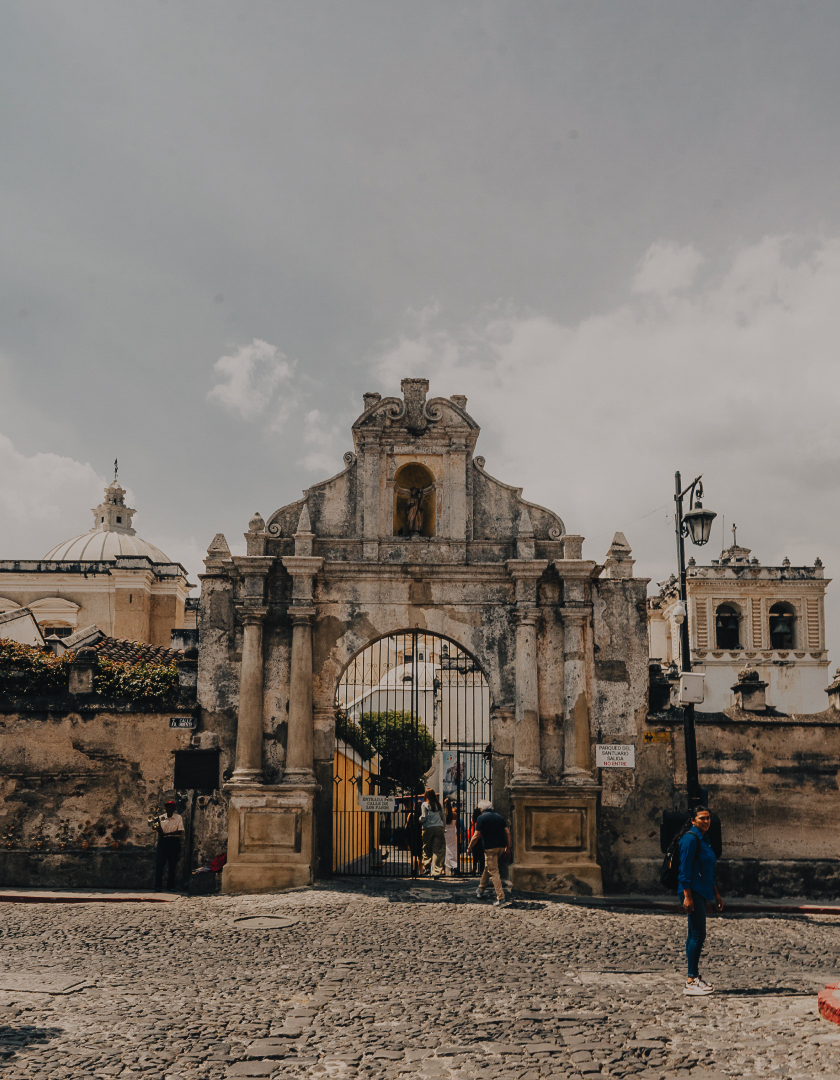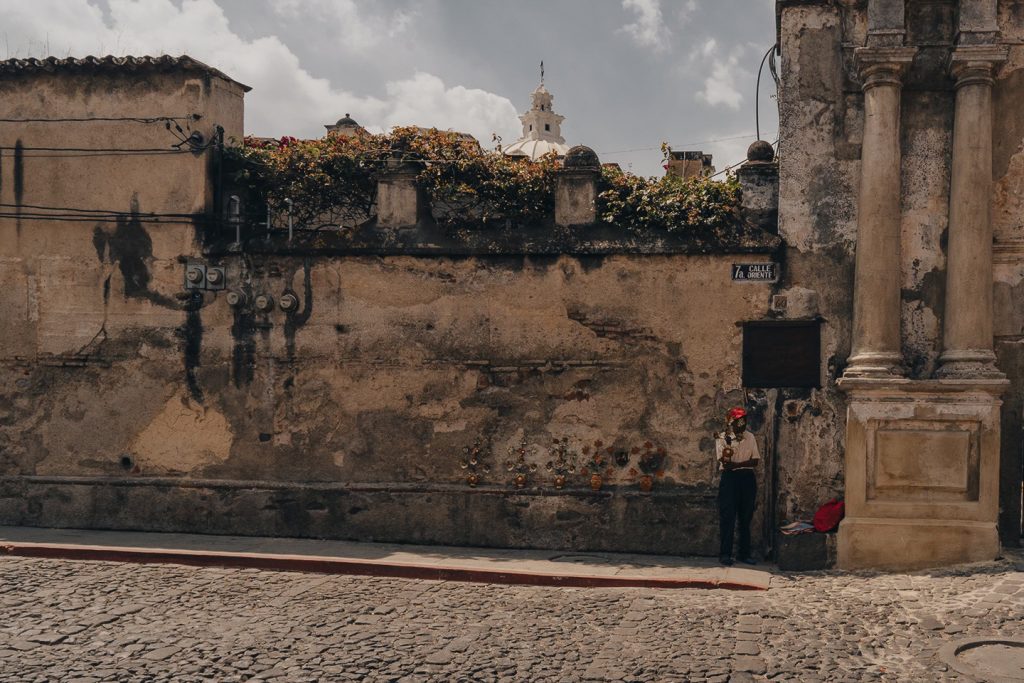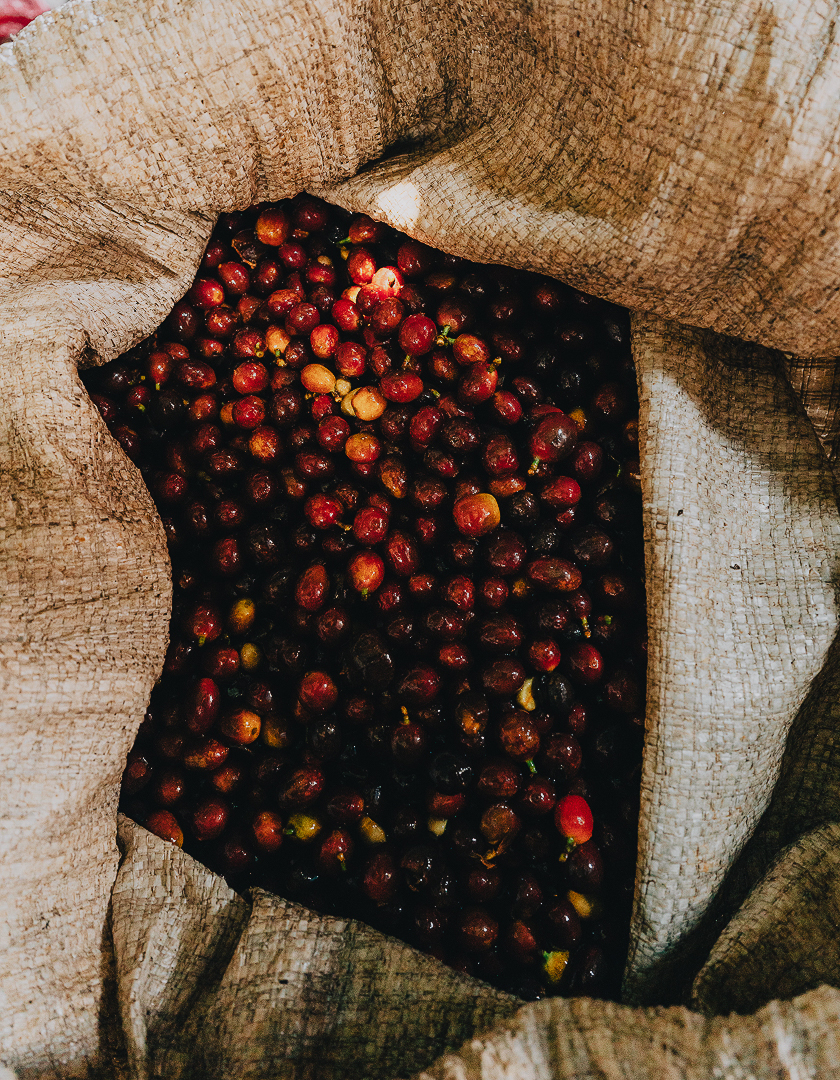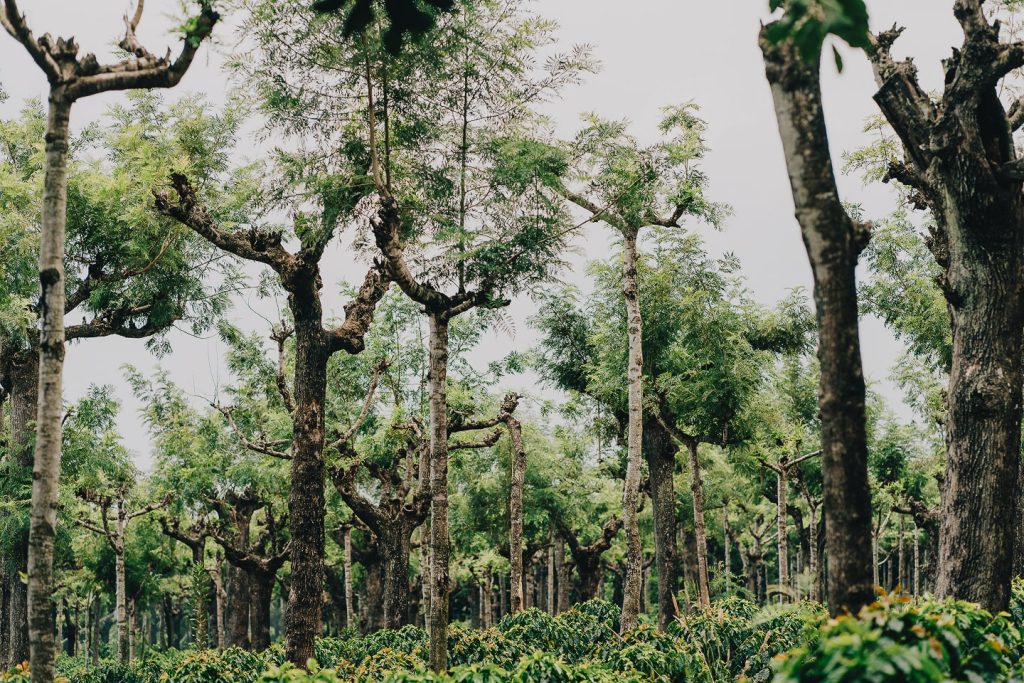In the shadow of volcanoes and beneath the baroque, custard-and-cream colonial facades of Antigua – pronounced the Spanish way, “An-tee-gwa” – photographer Nirvana Nungaray captures a richly saturated celebration of life. There’s a buzz about the city, yes, but it’s a quiet one; modern-day mopeds and tuk-tuks, coffee shops that serve pour overs, and the occasional glint of blingy grills flashed in the smiles of young locals all merging seamlessly into a bigger tapestry of crumbling churches, tranquil convent gardens and candlelit cloisters. It’s a landscape that makes the passing of a few hours – or a few years – seem immaterial, a sensation that’s perhaps down to the fact that Antigua is watched over by a string of smouldering volcanoes formed millions of years ago. Or, perhaps, to the endlessly renewing abundance of the surrounding land – from its corn fields to its jungle-like forests. Or, perhaps, just the rum.


Inside the ruins of San José Cathedral, left, and the building's facade
Guatemala is one of Latin America’s lesser-known sugar spirit heavyweights. Ask for an espresso martini in Antigua’s bar Ulew (Mayan for “Mother Earth”) – a cool, subterranean hangout accessed via a red phone box inside Antigua Brewing Company – and, chances are, the beans for the coffee will have come from a finca a stone’s throw away. And the rum, if you’re lucky, will be Zacapa. Crafted from first-press sugarcane grown in the country’s southern coastal region, then aged at 2,300m above sea level at the company’s “House Above the Clouds” in the Quetzaltenango highlands, the spirit is finished here, in the central highlands, under the bold direction of trailblazing master blender Lorena Vásquez.
Guatemala is one of Latin America’s lesser-known sugar spirit heavyweights. Ask for an espresso martini in Antigua’s bar Ulew (Mayan for “Mother Earth”) – a cool, subterranean hangout accessed via a red phone box inside Antigua Brewing Company – and, chances are, the beans for the coffee will have come from a finca a stone’s throw away. And the rum, if you’re lucky, will be Zacapa. Crafted from first-press sugarcane grown in the country’s southern coastal region, then aged at 2,300m above sea level at the company’s “House Above the Clouds” in the Quetzaltenango highlands, the spirit is finished here, in the central highlands, under the bold direction of trailblazing master blender Lorena Vásquez.




Clockwise from top left: San José Cathedral, detail; Iglesia de San Francisco; Church of St Peter the Apostle; street vendors
SUITCASE travelled to Antigua with the Jalisco-born, Mexico City-based Nungaray – who was given her first camera by her grandfather at the age of 14 – to meet Vásquez and explore the region; a compelling marriage of cobbled streets and verdant valleys, tradition and transformation. Born in Nicaragua, Vásquez has spent nearly four decades in her adopted homeland, refining Ron Zacapa’s signature style. Trained in chemistry and food technology, the rum maestra started out focused on the nuts and bolts of the business – textures, temperatures, idiosyncrasies – before ascending the ranks to join the rarefied circle of those currently blending spirits at the highest level. “Nada es fácil en la vida (nothing is easy in life),” she says, through her translator, when we ask what advice she might give to a young woman starting out today. “Pero cuando uno quiere, se puede (but when you really want something, you can accomplish it).”
SUITCASE travelled to Antigua with the Jalisco-born, Mexico City-based Nungaray – who was given her first camera by her grandfather at the age of 14 – to meet Vásquez and explore the region; a compelling marriage of cobbled streets and verdant valleys, tradition and transformation. Born in Nicaragua, Vásquez has spent nearly four decades in her adopted homeland, refining Ron Zacapa’s signature style. Trained in chemistry and food technology, the rum maestra started out focused on the nuts and bolts of the business – textures, temperatures, idiosyncrasies – before ascending the ranks to join the rarefied circle of those currently blending spirits at the highest level. “Nada es fácil en la vida (nothing is easy in life),” she says, through her translator, when we ask what advice she might give to a young woman starting out today. “Pero cuando uno quiere, se puede (but when you really want something, you can accomplish it).”

A street vendor outside Iglesia de San Francisco
Resilience runs like a thread through these parts. Born of eruptions and rebuilt in defiance, Antigua was founded under Spanish colonial rule in 1524, destroyed by rebellion in the 16th century, again by a volcanic landslide, and then once more by an earthquake in 1773 – leading to the relocation of the capital to Guatemala City. First-time visitors might expect a ghost town, but rather, the city – designated a Unesco World Heritage site in 1979 – thrives.
Resilience runs like a thread through these parts. Born of eruptions and rebuilt in defiance, Antigua was founded under Spanish colonial rule in 1524, destroyed by rebellion in the 16th century, again by a volcanic landslide, and then once more by an earthquake in 1773 – leading to the relocation of the capital to Guatemala City. First-time visitors might expect a ghost town, but rather, the city – designated a Unesco World Heritage site in 1979 – thrives.


Lunch at Casa Troccoli, left, and Finca El Tempixque coffee cherries
Vásquez took time out to join us on the estate of boutique hotel Villa Bokéh. There, we tried our hand at creating our own rum in Zacapa’s state-of-the-art blending facility, which, with its towers of wooden barrels, shimmering glassware, gilt tableware and glossy verdure, could pass as a tropical hideaway from a classic Bond film. Set amid two hectares of gardens, lakes and fountains, it offers front-row-seat views of Agua, the volcano that serves as Antigua’s compass, and whose last known eruption occurred in the Late Pleistocene epoch.
Rum has been made in Guatemala since the colonial era, and by Zacapa since 1976, benefitting both from the country’s generous natural larder and, since 1984, Vásquez’ creativity and alchemy – or “voodoo”, as some rum lovers might call it. Made with a sugarcane base rather than the molasses typically used in other pours, Zacapa’s inherent connection to the land only adds to the magic, with altitude, soil, heat and rainfall all contributing to its signature character.
Vásquez took time out to join us on the estate of boutique hotel Villa Bokéh. There, we tried our hand at creating our own rum in Zacapa’s state-of-the-art blending facility, which, with its towers of wooden barrels, shimmering glassware, gilt tableware and glossy verdure, could pass as a tropical hideaway from a classic Bond film. Set amid two hectares of gardens, lakes and fountains, it offers front-row-seat views of Agua, the volcano that serves as Antigua’s compass, and whose last known eruption occurred in the Late Pleistocene epoch.
Rum has been made in Guatemala since the colonial era, and by Zacapa since 1976, benefitting both from the country’s generous natural larder and, since 1984, Vásquez’ creativity and alchemy – or “voodoo”, as some rum lovers might call it. Made with a sugarcane base rather than the molasses typically used in other pours, Zacapa’s inherent connection to the land only adds to the magic, with altitude, soil, heat and rainfall all contributing to its signature character.




Clockwise from top left: workers at Finca El Tempixque; some of the farm's coffee plants; master rum blender Lorena Vásquez; coffee plants in flower
Vásquez joined us, too, on a visit to coffee farm Finca El Tempixque, where she led a mixology workshop that saw the richness of Zacapa combined with the robust coffee grown here by the Falla family since the 1960s in a duo of knockout cocktails. The coffee beans are hand-harvested and meticulously processed, before being packed into sacks and shipped to cafés around the world. El Tempixque also cultivates orchids – including the White Nun varietal, Guatemala’s national flower – which feature subtly in Zacapa’s branding. While they bloom with the boisterousness of British dandelions in Antigua’s temperate climate – daytime highs were a pleasant 25ºC during our visit in spring – it’s the coffee plants that steal the show. Delicate white blossoms give way to bright red cherries shaded beneath towering grevillea trees, framed by cinematic views of those primordial-looking peaks beyond.
Vásquez joined us, too, on a visit to coffee farm Finca El Tempixque, where she led a mixology workshop that saw the richness of Zacapa combined with the robust coffee grown here by the Falla family since the 1960s in a duo of knockout cocktails. The coffee beans are hand-harvested and meticulously processed, before being packed into sacks and shipped to cafés around the world. El Tempixque also cultivates orchids – including the White Nun varietal, Guatemala’s national flower – which feature subtly in Zacapa’s branding. While they bloom with the boisterousness of British dandelions in Antigua’s temperate climate – daytime highs were a pleasant 25ºC during our visit in spring – it’s the coffee plants that steal the show. Delicate white blossoms give way to bright red cherries shaded beneath towering grevillea trees, framed by cinematic views of those primordial-looking peaks beyond.

Grevillea trees and coffee plants at Finca El Tempixque
At Casa Troccoli, a 450-year-old former pharmacy and family residence turned delicatessen, wine shop, restaurant and events venue, we feasted on corn tortillas fresh off the comal (flat griddle) and vibrant salads, followed by never-to-be-forgotten dulce de leche-based sweets, at tables adorned with locally crafted cloths and overlooked by ceramic owls – ubiquitous in Guatemalan homes, the bird being associated with prosperity.
At Casa Troccoli, a 450-year-old former pharmacy and family residence turned delicatessen, wine shop, restaurant and events venue, we feasted on corn tortillas fresh off the comal (flat griddle) and vibrant salads, followed by never-to-be-forgotten dulce de leche-based sweets, at tables adorned with locally crafted cloths and overlooked by ceramic owls – ubiquitous in Guatemalan homes, the bird being associated with prosperity.

Petate weavers
On our final evening in Antigua, at our base, the serene Hotel Casa Santo Domingo, a former convent, Vásquez introduced us to a group of local weavers – women who craft the intricate petate bands that adorn every bottle of Zacapa. Made from dried palm, these handwoven rings are a legacy of Maya backstrap weaving, an age-old method in which the loom is anchored to a fixed object at one end and wrapped around the weaver’s waist at the other. Since 1976, women from El Progreso, El Quiché and Jocotán – many of whom have faced displacement, drought or economic hardship – have joined Zacapa’s weaving programme. Today, more than 700 women contribute, so that each bottle carries a story of skill, heritage and strength. In celebrating their artistry, Zacapa is helping to preserve cultural knowledge while providing them with a meaningful, sustainable income.
On our final evening in Antigua, at our base, the serene Hotel Casa Santo Domingo, a former convent, Vásquez introduced us to a group of local weavers – women who craft the intricate petate bands that adorn every bottle of Zacapa. Made from dried palm, these handwoven rings are a legacy of Maya backstrap weaving, an age-old method in which the loom is anchored to a fixed object at one end and wrapped around the weaver’s waist at the other. Since 1976, women from El Progreso, El Quiché and Jocotán – many of whom have faced displacement, drought or economic hardship – have joined Zacapa’s weaving programme. Today, more than 700 women contribute, so that each bottle carries a story of skill, heritage and strength. In celebrating their artistry, Zacapa is helping to preserve cultural knowledge while providing them with a meaningful, sustainable income.


Weaving dried palm, left, and a local weaver
Nungaray’s soulful images are a toast to Antigua’s essential stillness – and perpetual motion. A glass raised to the quiet joy of a coffee harvested by hand. The long, sweet burn of a good rum. And to a beauty that shines on not despite impermanence, but because of it.
Nungaray’s soulful images are a toast to Antigua’s essential stillness – and perpetual motion. A glass raised to the quiet joy of a coffee harvested by hand. The long, sweet burn of a good rum. And to a beauty that shines on not despite impermanence, but because of it.

Coffee beans drying at Finca El Tempixque



